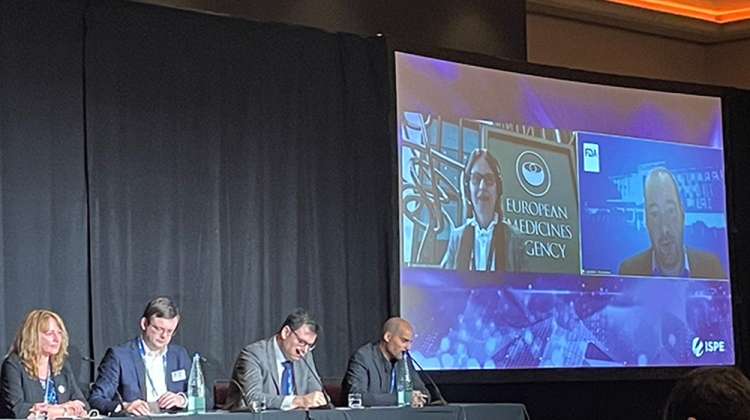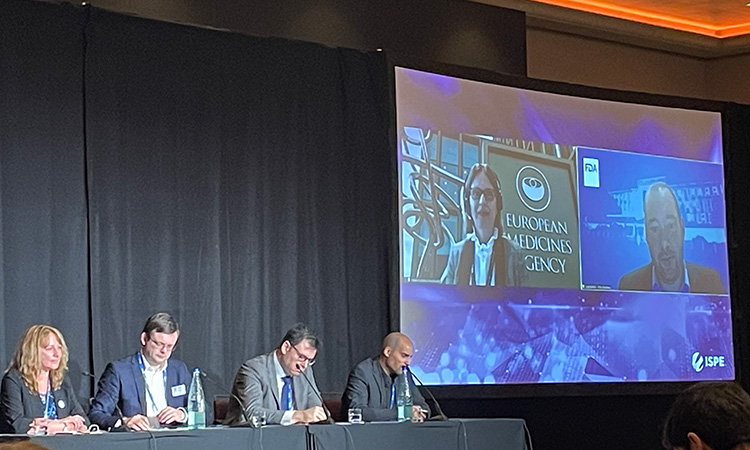Practical Applications of Current Standards and Regulations in the Context of Digitalization

At the 2023 ISPE Pharma 4.0™ and Annex 1 Conference, held 11 – 12 December 2023 in Barcelona, Spain, a panel discussion that included regulators from around the world, as well as industry experts, offered attendees insights and discussion regarding new technologies including Artificial Intelligence (AI).
The panel, titled “Practical Applications of Current Standards and Regulations in the Context of Digitalization,” was moderated by David Churchward, Head of Operations Quality, Compliance and External Affairs, AstraZeneca; and Yvonne Duckworth, PE, Fellow – Digital Technology, Associate, CRB.
Panelists included:

Questions posed to the panelists included those regarding AI and its application and effects on regulatory issues; proposals and applications sent to regulators; questions regarding the US FDA and EMA reflection papers on AI; the US FDA’s Emerging Technology Program; AI’s effect on manufacturing and control; and the future of digitalization on the industry.
Question # 1: Could the panelists outline key points that industry should consider when sending out novel proposals to regulators, and what elements do regulators look for regarding assurance that risks are being well managed?
Korakianiti began by suggesting that a good example of what regulators look for can be seen in the first application reviewed by the US FDA for continuous API manufacturing when scientific advice was developed in parallel to the review process. Lorente added that the necessary expertise may not exist within the organization, but it may be useful to know how this expertise can be obtained and subsequently incorporated into the organization’s quality management system (QMS) decision-making process.
Canzoneri explained that while we may still be learning about AI, the industry is already applying AI when screening new molecules, for example. He said that AI is more than just digitalization and may be used to leverage quality data — with many benefits. He said he that believed that we could all learn from each other to the benefit of the industry, and that this idea is in keeping with the objective of Pharma 4.0TM.
Question # 2: As the revised Annex 1 took seven years before it was finally published in 2022, will the time it takes to update regulations hinder the application of emerging technologies, such as AI?
According to Welch, the US FDA’s Emergency Technology Program was initiated to help with the introduction of new and emerging technologies and that guidance documents and industry conferences also can be effective at establishing key principles related to AI. Lorente concurred when he noted that guidelines and regulations are not necessary for new technologies and that many principles for managing new technologies are already in place; for example, those defining the scope, level of supervision and automation and with risk assessments capturing any changes in algorithms.
From the EMA’s point of view, Korakianiti commented that the agency has developed the Quality Innovation Group (QIG) for new technologies. She noted that it was important to create a flexible and adaptable framework and that early engagement with the EMA is always recommended for evolving guidance, Q&A documents, and regular updates. Canzoneri added that the amount of effort required will be determined by the number of use cases, and that the effectiveness and standardization of AI is important for adopting AI to accelerate the digital transformation.
Question # 3: What is the regulatory view on the use of generative AI, and how do you see them used in our industry?
The US FDA, EMA and AEMPS panelists said that they had no direct experience of use cases with AI. However, Korakianiti referenced that the EMA task force, whose members are collaborating with AI developers, have noticed that pharmacovigilance is a target area of concern. She also said that the EMA would always evaluate AI in the context of a product and process. Canzoneri explained that generative AI became popular a year ago for clinical reports and has also been used to generate Standard Operating Procedures (SOPs) – it’s an exciting area, he said, but barriers exist in the form of biased data. Lorente commented that the source and integrity of data is important.
Question #4: Can anyone comment on the AI discussion paper from the [US] FDA and the reflection paper on AI by the EMA and explain the next steps for this initiative?
Korakianiti stated that after receiving feedback on the EMA’s AI reflection paper in 2023, a work plan will be developed and communicated early in 2024.
From the US FDA’s perspective, Welch indicated that there is a lot of excitement in this area and having “core principles” is key to the success of AI, along with a consistent terminology and with platforms and systems that support AI.
Question # 5: What are regulator’s experiences with electronic and virtual training? Does personnel training and experience become more challenging when reliant on electronic or virtual platforms?
Lorente offered that we can expect to see many improvements when generating documentation and reports, which agency inspectors will welcome. Korakianiti observed that relationships and trust will be important as training is likely to be a combination of being “live” as well as virtual.
Church interjected that there is unlikely to be a one-size-fits-all approach and that “e-learning” may be useful in conveying concepts — such as movement inside the aseptic core — with the added benefit of not compromising the classified space. As useful as e-learning training might be, he suggested that it does not — at the moment — seem to be replacing ‘in person’ training.
Question # 6: There was a re-vamping of the [US] FDA’s “Emerging Technology Program” [ETP] a few years ago in order to help grow the program and meet the demands of the industry. What is its status today?
Welch stressed that there is a need to identify challenges in new technology early in development and that early engagement is key; however, there could be a series of engagements. The application process requires a submission of five pages or fewer, but he added that it is not essential that a product is referenced. Once the US FDA has assigned a member of the ETP team to the technology, they will remain with the technology for the duration. He emphasized that the US FDA would evaluate whether the timing is right for the technology, as well as how it might be enhanced via a collaborative approach. The US FDA can assist with a technology’s “graduation,” he said, and also determine whether there is a need for training, publication, or developing a standard assessment process.
Korakianiti added that within the EMA there is an equivalent Quality Innovation Group (QIG). It was formed a year ago and operates in much the same way as the FDA’s ETP team.
Canzoneri suggested that having an available dialogue with the FDA and EMA on new technologies and innovations has been welcomed by the industry and is encouraged, adding that there is currently a lot of attention paid to academia.
Question # 7: The most recently published and harmonized GMP standard, Annex 1, delivered a significant increase in detail in setting out regulatory expectations for sterile manufacturing. Can we expect the same level of detail in guidance relating to AI applications in pharmaceutical manufacturing and control?
Korakianiti said that the approach for AI is expected to be very different to Annex 1 because industry is still learning about AI, whereas with Annex 1, there was a good basis on which to build. She suggested that, for AI, the regulatory focus is more likely to be on guiding principles rather than on the detail and that the proposed Annex 11 update on computerized systems is expected to help.
Lorente agreed and said that while the revised Annex 1 deliverable was always very clear, that cannot be said for AI.
Too much detail will limit innovation, responded Canzoneri. He suggested that algorithms will need to form part of the AI submissions, and they will change, and we will need to understand how to handle changing algorithms. He concluded that more guidance is needed, and continuing guidance and collaboration may be necessary.
Question # 8: With respect to digitalization, where do you see the industry in five to 10 years?
Canzoneri responded by saying that we can expect to see a high level of maturity in the application of AI. It will be with full understanding, transparency, a trustworthy framework, and established technical providers. He added that he expected that algorithms will be secure, protected and integrated into work processes. He cautioned that, going forward, we need to understand the required skill sets and start planning for these skills.
Welch added that in five to ten years AI will no longer be in a silo. Rather, it will be embedded in everything we do and not a standalone technology.
Korakianiti added that the EMA would like to see a mature application of AI to address current capacity constraints, while Lorente said that the AEMPS would like to see a transition from AI to increased knowledge, with a more robust supply chain that is more reliable and predictable than the current supply chain.
Disclaimer:
This is an informal summary of a discussion panel held on 11 December 2023 at the 2023 ISPE Pharma 4.0™ and Annex 1 Conference, in Barcelona, Spain. It has not been vetted by any of the agencies or regulators cited in this article, nor should it be considered the official positions of any of the agencies present.






